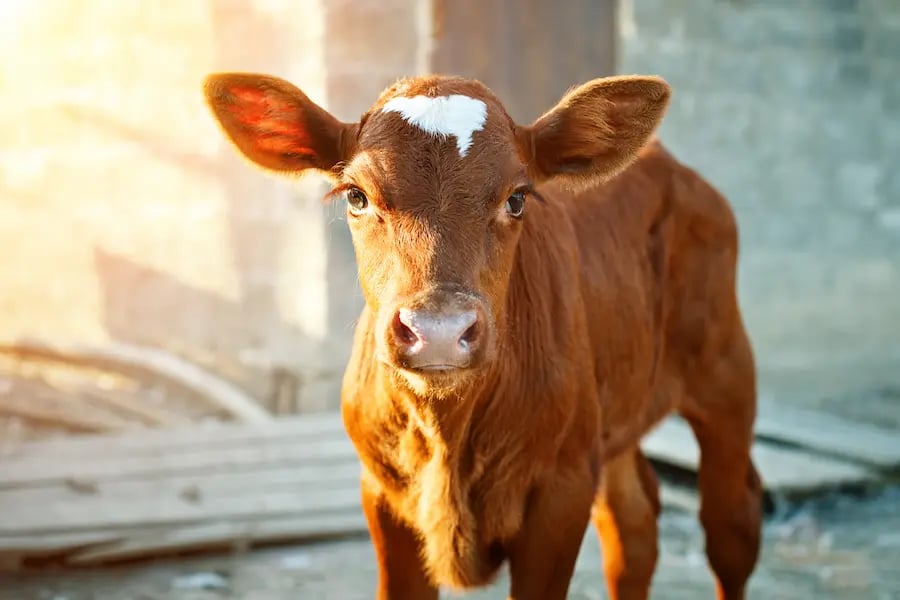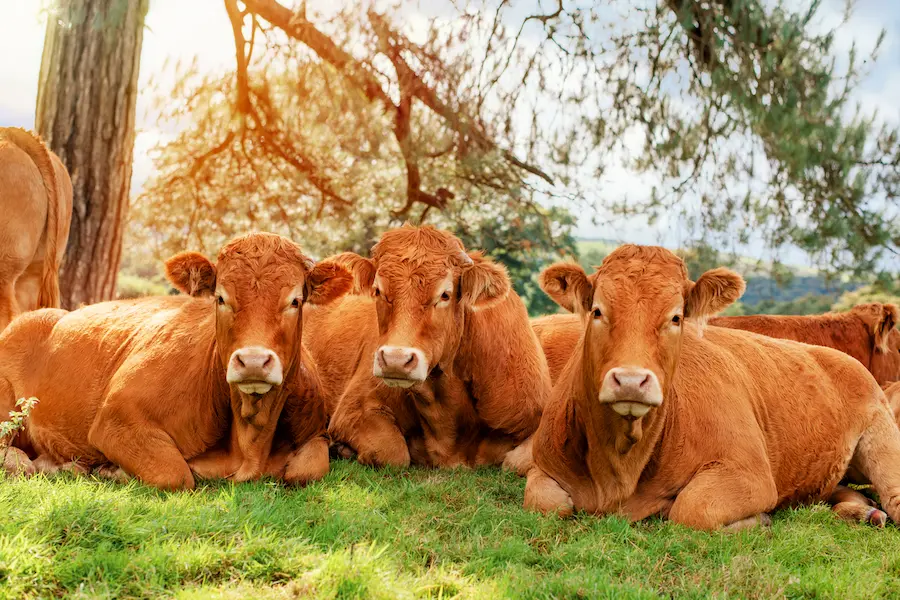In beef cattle, several factors, such as genetics, nutrition, health, or reproductive efficiency determine the productivity and, consequently, the economic profitability of the animals. Among all these elements, the time at which these animals reach puberty is perhaps the first one to consider.
Prefer to listen to this article? Click the play button below and enjoy our podcast!
Puberty is the age at which the gonads produce gametes and sex hormones in sufficient quantity for the animal to be able to reproduce. In other words, puberty is the moment when an animal becomes capable of reproducing for the first time.
This parameter influences the timing of the first mating/artificial insemination and indirectly determines the timing of the first calving, which can be considered the beginning of a cow's productive life.
In a study conducted in Spain on more than 7500 Blonde d'Aquitaine breed cows, it was observed that heifers whose first calving occurred between 20 and 27 months of age provided an extra profit of €28 per slaughtered calf compared to those that calved for the first time between 40 and 48 months1. Although some studies have linked earlier calving to certain subsequent problems that would negatively affect their later productive capacity, such as an increase in calving difficulty or the incidence of dystocia2, in López-Paredes' 2018 study, the reduction in the birth-to-first-calving interval did not affect either the productive or reproductive development of the animals later on.
Factors Influencing Puberty Onset
For a heifer to reach puberty, GnRH must be secreted in sufficient quantities in the hypothalamus to stimulate the production of LH in the pituitary gland. In turn, a sufficient amount of LH is needed to stimulate the final growth of the follicles, so they produce enough estradiol to induce the LH peak necessary for ovulation.

It is well-established that age, weight, nutritional status, genotype, and season are factors that significantly influence the regulation of this process. Below is a brief summary of the importance of each3:
- Age and weight: Although age is an important factor, we can affirm that heifers reach puberty when their body weight reaches 55%-60% of the weight of an adult animal. Therefore, puberty onset is closely linked to the growth rate and, consequently, to nutrition.
- Nutrition: It is a determining factor in the timing of heifers reaching puberty, as it largely determines the animal's growth and the moment when it reaches the appropriate weight. Asdell demonstrated this effect in a study conducted in 19554, finding that heifers fed with high, medium, or low nutritional levels reached puberty at 9, 11, or 15 months, respectively. Nutrition affects the synthesis and release of sex hormones that regulate the onset of ovarian activity in heifers in a similar way to what happens during the postpartum period, with the resumption of ovarian activity. This effect is mediated by different endocrine factors:
- Leptin: This is an adipokine produced mostly by adipocytes, and its function is to send a signal to the brain indicating the organism's nutritional status and thus regulate food intake. It also informs the hypothalamus-pituitary axis, regulating the reproductive function.
- Insulin: This is a hormone produced by the pancreas, whose main purpose is to regulate glucose concentrations. Insulin increases when glucose levels rise, but it also intervenes in reproduction, as it stimulates the secretion of GnRH and LH. In situations of low nutritional levels, insulin levels will be low, and its effect on sex hormones can delay the onset of puberty.
- GH: GH production is also influenced by glucose levels, so low glucose levels stimulate GH release, which, in turn, could be related to a reduction in LH secretion.
- Season: This factor influences puberty in different ways:
- Photoperiod: Although cows are not seasonal breeders, there is a certain effect of photoperiod on reproduction. This effect, similar to that in species with seasonal reproduction such as small ruminants or horses, is mediated by melatonin, secreted by the pineal gland during dark hours. In the case of cows, it has been proposed that this hormone might impair LH secretion, thus affecting reproduction in general and the onset of puberty in particular. Heifers born in autumn reach puberty earlier than those born in spring.
- Temperature/Humidity: High temperatures negatively influence puberty onset, especially when combined with high humidity. This effect is similar to that observed in adult animals due to heat stress, reducing fertility in adults and delaying puberty in prepubertal animals.

Strategies to Accelerate Puberty Onset
Given the aforementioned points, different strategies can be proposed to accelerate puberty onset and thus increase the profitability of beef cattle farms.
- Nutritional Strategies: Considering that one of the most important factors determining puberty onset in cows is weight and nutrition, it is clear that the main strategies to accelerate puberty onset should be based on providing adequate nutrition that allows the necessary weight to be reached as soon as possible. This strategy has been successfully tested in numerous studies, confirming that higher weight gain may accelerate puberty onset and that heifers with higher weight at the beginning of the reproductive season were generally more fertile6.
- Hormonal Protocols: Along with adequate nutritional strategies, hormonal insemination protocols at a fixed time (TAI) can be applied to accelerate puberty onset.
The use of progesterone devices allows to anticipate the first fertile ovulation, normally heifers would have a first ovulation followed by a short luteal phase in case these heifers would be bred, the embryos would not survive as there will be a premature release of prostaglandin F2 alpha 8 to 10 days and the heifer will return to oestrus. The use of a progesterone releasing intravaginal device, allows for a synchronous ovulation and a normal length CL lifespan, the protocols for heifers can vary in duration from 5 to 7 up to 14 days in some cases.
Progesterone is of the used in combination with other hormones such as GnRH and eCG (equine chorionic gonadotropin), in order to control follicular wave emergence and follicular maturation and ovulation.
These protocols are most effective when used in the proximity of the naturally occurring pubertal period, they are in fact, capable of inducing timed ovulation in more than 80% of the treated at 12 month of age4. - Manipulation of Photoperiod: As mentioned in the previous section, since heifers born in spring present delayed puberty onset compared to those born in autumn due to the photoperiod effect, light supplementation from 22-24 weeks of age reduces the age at first ovulation in these animals7. However, this system involves keeping animals housed in suitable facilities.
Conclusion
In beef cattle, early puberty onset allows for the first calving around 24 months, thereby increasing the profitability of the farm. Many factors influence puberty onset, but probably the most important ones are genetics and body weight/age. An appropriate nutritional strategy that allows for adequate weight gain to reach the required weight as soon as possible, along with a TAI protocol in the final weeks, will advance puberty onset and increase farm profitability.
References
- López-Paredes, J., Pérez-Cabal, M. A., Jiménez-Montero, J. A., & Alenda, R. (2018). Influence of age at first calving in a continuous calving season on productive, functional, and economic performance in a Blonde d’Aquitaine beef population. Journal of animal science, 96(10), 4015-4027.
- Twomey, A. J., & Cromie, A. R. (2023). Impact of age at first calving on performance traits in Irish beef herds. Journal of animal science, 101, skad008.
- Vasantha, S. K. I., & Kona, S. S. R. (2016). Physiology of puberty in females: A review. International Journal of Veterinary Sciences and Animal Husbandry, 1(2), 23-26.
- Michael L. Day, Guilherme P. Nogueira, (2013) Management of age at puberty in beef heifers to optimize efficiency of beef production, Animal Frontiers, Volume 3, Issue 4, Pages 6–11
- Asdell, S. A. (1955). Cattle fertility and sterility. Cattle fertility and sterility. Boston, Mass.: Little, Brown.
- Moorey, S. E., & Biase, F. H. (2020). Beef heifer fertility: importance of management practices and technological advancements. Journal of animal science and biotechnology, 11(1), 1-12.
- Hansen PJ, Kamwanja LA, Hauser ER. (1983) Photoperiod influences age at puberty of heifers. Journal of Animal Science; 57(4):985-92.
About the author
Federico Randi (Ruminants Global Technical Manager)
Federico Randi is Global Technical Manager for Ruminants at Ceva Animal Health, specializing in cattle reproduction. With a Doctor of Veterinary Medicine degree “cum laude” from the University of Bologna, he focused his career on improving efficiency and sustainability of farmed animals. Randi conducts research on ruminants fertility, using technologies like Timed AI, embryo transfer, and recombinant technologies. His extensive experience includes collaborative projects with over 20 research institutions globally. He earned his PhD at University College Dublin, concentrating on fixed-time artificial insemination and embryonic maternal communication in cattle. Currently, he serves as a Board Member in the Scientific Commission of Animal Physiology for the European Federation of Animal Science (EAAP) as an Industry Representative.
About the author
Dr. Luis A. Quintela (Senior Lecturer in Animal Reproduction)
Professor in the Department of Animal Pathology at the Veterinary Faculty in Lugo, Unvidersidade de Santiago de Compostela (USC). Graduate with a DVM in 1989 and PhD in Veterinary Science in 1996 at the USC. Teaching reproduction and obstetrics, veterinary clinical ultrasound and dairy cattle medicine for graduate and MA students. Adviser in reproduction for a pharmaceutical company since 2007. In the field of investigation, he has participated in and directed several research projects and collaborated with I+D+I programs of several pharmaceutical companies. He has more than one hundred articles of investigation and divulgation and more than one hundred thirty meeting abstracts in national and international congress, he has eight books or book chapters, and he has a patent in exploitation. Most of his works were developed in the field of reproduction in cattle.
About the author
Uxía Yáñez (Predoctoral Fellow)
Assistant Researcher, Universidade de Santiago de Compostela (USC). PhD in Veterinary Medicine and Health by at USC in 2023. Her research activity is focused on ultrasonography and its applications in the reproductive management of dairy cattle, as well as the influence of peripartum diseases on the profitability of the farms. Additionally, her work involves practical teaching sessions about cattle reproduction at the Faculty of Veterinary Medicine in Lugo (Galicia, Spain).




Leave your comments here